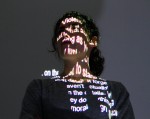Projected silhouettes will illuminate the issues of corruption and persecuted journalists.
Graduate design media arts student Zeynep Abes’ exhibition at the Broad Art Center will feature interactive video projection technology. The interactive projections are triggered by the presence of a viewer, revealing hidden text when activated. On display Tuesday, the artwork aims to raise awareness of journalists’ rights and struggles in various countries.
Abes said the abuse of laws, like stringent censorship, in her homeland of Turkey led her to pursue artwork with political connotations. Berfin Ataman, another graduate student and Abes’ friend, said Abes’ artwork has dealt with topics like issues Muslim women encounter, but usually focuses on the political issues in Turkey. For example, because of the Turkish government’s strict policies on censorship, Abes had to be secretive with her work, so she created, instead, augmented reality graffiti images that can be viewed only on a mobile app in select locations of the country, Ataman said.
“She does these AR graffiti with your phone that you can see around Turkey in certain locations that have different connotations. It’s hard to be political about it if you’re Turkish,” Ataman said. “You always have to find clever ways of doing it.”
Even now, Abes said Turkey remains a dangerous country for journalists. Both the government officials’ abuse of the laws for their own benefit and the silencing of journalists inspired the exhibit’s pieces. After a 2013 protest in Turkey decrying the government’s stance against freedom of speech, a blogger released a document online criticizing how the government “fairly” imprisons people without backlash from the populace, Abes said. Abes said her text, along with names of imprisoned journalists, were included as part of the interactive projection. The text aims to broaden the issue of imprisoned journalists to government corruption, Abes added.
“(The text is) basically related to unjust imprisonment of people,” Abes said. “It’s just questioning the ethics of how the government has this control over people, saying it’s the law, but it can be so unfair. And journalists are people who get hit by this a lot.”
On the two side walls, projectors will cast prerecorded videos of human silhouettes, said Devin Embil, who helped Abes with the video projection. Demarcated with a white outline, the silhouettes pace back and forth only within the boundaries of the wall, giving the feeling of being trapped, Embil said.
“(The silhouettes) move around. They look even distressed,” Embil said. “They feel trapped. … In a way, if you look at it long enough, it almost feels like you’re looking at someone even though it’s just a projection.”
On the main wall, an interactive projector seemingly projects nothing onto a screen. However, when someone stands in between the projector and the screen, names of journalists who have been imprisoned are revealed in the person’s digital shadow. The text scrolls horizontally across the wall, so to track the texts, the viewer must move, matching the speed of the text with their shadow. Abes said she incorporated the feature of movement to create a dichotomy between the silhouettes looking trapped and the viewers being able to move freely.
“I wanted to contradict that sort of feeling trapped of those with you,” Abes said. “I wanted to create that contrast between you as a viewer noticing your freedom, your movement.”
With all three projections, Abes said she aims to bring awareness to the censorship and arrests journalists face, especially in countries like Turkey, China and Mexico. Additionally, Abes said she hopes viewers will reflect on the freedoms, like freedom of speech, they possess in the U.S.
“(I want people to) think about what it would be like if no one was allowed to talk about what was going on in the country,” Abes said. “What if that happened in the States? That feeling of not having the freedom to say anything about an issue and why the job of journalists is so important because of this.”
